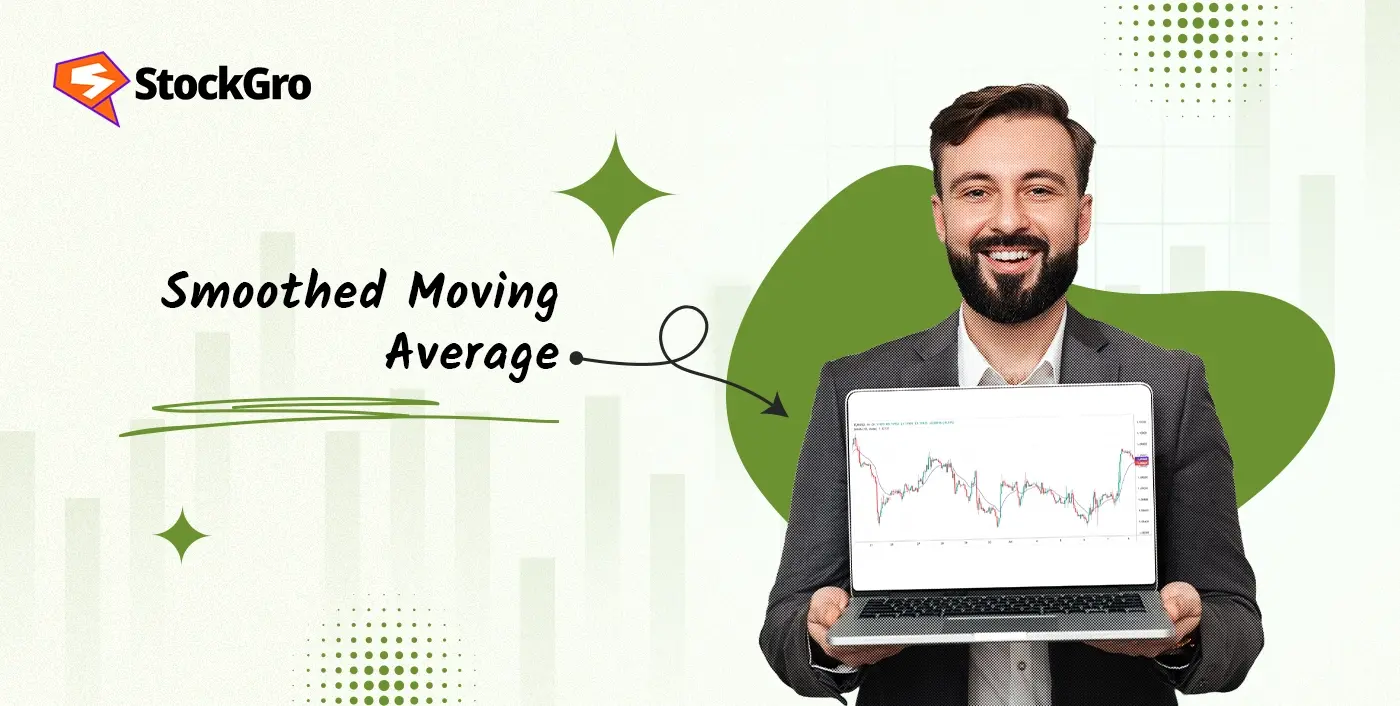
When it comes to evaluating price trends in trading, moving average tools are mainly used. While the Exponential Moving Average (EMA) and Simple Moving Average (SMA) are already popular, there’s another significant indicator that’s silently offering a powerful edge, Smoothed Moving Average (SMMA). Traders seeking a more stable line that filters out price noise use this moving average for clarity in view of the trend.
Let’s discover how the SMMA functions, how to utilise it properly, and why it might be the missing piece in your trading approach.
What is a Smoothed Moving Average?
A Smoothed Moving Average is a kind of moving average that analyses recent price to historical data but over a longer period, helping eliminate temporary swings. Contrasting with EMA, which rapidly gets triggered by price fluctuations, or the SMA which averages over a certain period, the SMMA technical indicator gives more weight to historical data, offering a seamless line.
How Does a Smoothed Moving Average Work?
The SMMA uses previous and recent price data that create a stable average to function properly. Every latest SMMA value is calculated by taking the prior SMMA value and minutely fine-tuning it depending on the latest one. This method leads to a line that is less vulnerable to temporary spikes and drops, making it more seamless than an EMA or SMA.
Briefly, the SMMA is designed to highlight the trend clearly by overlooking the “noise” caused by temporary price drifts.
How to Calculate Smoothed Moving Average
The formula for SMMA is:
SMMA = (Past SMMA x (N – 1) + Latest Price) / N.
Where:
N = Number of periods.
Previous SMMA= Value of SMMA from the previous period.
Latest Price = The latest closing price.
This recursive formula validates that the SMMA line steadily evolves over time. The initial SMMA value is usually calculated as a basic average as a price over the initial N periods.
Best Settings for Smoothed Moving Average
There’s no universal setting for SMMA. The best period setting lies in your trading pattern. However, here are some popular settings:
- Short Term Traders: 14 and 28
- Long Term Traders: 50, 100 and 200
Smoothed Moving Average Vs Simple Moving Average (SMA) vs Exponential Moving Average (EMA)
| Feature | Smoothed Moving Average (SMMA) | Simple Moving Average (SMA) | Exponential Moving Average (EMA) |
| Speed | Slowly reacts, as it takes a longer series of past data into account. | Slow because it offers equal weight to all values in the period. | Faster, as it gives more weight to latest prices for quicker responses. |
| Smoothness | Extremely seamless. Perfect for refining temporary swings. | A bit less smooth, can show more temporary instability because of equal weighing. | Moderately smooth, balances responsiveness with some filtering. |
| Lag | Moderate to high, because of its extended memory of historical data points. | High lag, particularly in an ever-evolving market. | Low lag. Quickly adapts to price modifications because of its focus on latest data. |
| Reactivity | Low reactivity. Slowly changes with market drifts. | Low reactivity. Only reacts after a significant price drift. | High reactivity. Adjusts almost immediately to latest price fluctuations. |
| Best Use | Best for recognising sustainable trends and filtering market noise. | Best for a general trend overview but less effective in an unstable market. | Perfect for capturing temporary shifts and quick trend reversals. |
- SMA: Basic and understandable, but can be choppy.
- EMA: Quickly get triggered by price swings, ideal for temporary traders.
- SMMA: Ideal for reducing noise and recognising clear, long-term trends.
How to Use SMMA in Technical Analysis
Trend Identification
SMMA works best to determine the overall trend. When the price is incessantly beyond the SMMA, it specifies an uptrend. Similarly, a downtrend is when the price is less than SMMA. Its seamlessness gives a better view of the trend compared to EMA or SMA while doing technical analysis.
Entry and Exit Signals
SMMA can be integrated with other indicators or used on its own to time entry and exists:
- Buy Signal: When the price outdoes SMMA from below.
- Sell Signal: Where the price surpasses SMMA from above.
While these signals are infrequent due to the lag, they prove to be more consistent.
SMMA as Dynamic Support & Resistance
SMMA often functions as a resistance level or dynamic support like other moving averages, where prices may bounce off the SMMA line as a support area in an uptrend, whereas, in the downtrend it may act as resistance.
SMMA Trading Strategies
- SMMA + RSI
Application of SMMA alongside RSI (Relative Strength Index) can help confirm momentum. For instance:
- Enter long when RSI exceeds 50 and price is above SMMA.
- Go short or exit when RSI drops below 50 and price falls below SMMA.
This grouping helps you sort out misleading signals you might get if you’re using only RSI.
- SMMA + MACD
The Moving Average Convergence Divergence (MACD) seamlessly integrates with SMMA, where SMMA basically acts as a trend filter:
- Trade only in the Smoothed Moving Average trend movement.
- Use MACD edges or histogram indicators to schedule entries.
Such a tactic assists in lining up momentum with inclusive trends.
- SMMA + Price Action
Many investors choose the combined SMMA technical indicator with clean price action:
- Seeking bullish candlestick outlines such as engulfing, hammer, beyond the SMMA in an uptrend.
- Spotting bearish trends such as bearish engulfing, shooting stars beneath the SMMA in a downtrend.
This assists in retaining transparency in the chart while still offering high-probability trades.
To manage risk across all these strategies, consider placing your stop loss just beyond the Smoothed Moving Average or the nearest swing point.
Advantages of Using Smoothed Moving Average
- Clears Market Clatter: Provides a movement view with clarity by classifying minor price swings.
- Signal Strength: Does not trigger false breakouts and frequent whipsaws.
- Flexible: Functions effortlessly on a variety of asset classes and durations.
- Seamless Integration: Compatibility with momentum, volume, or price-based indicators is seamless.
Limitations of Smoothed Moving Average
- Delayed Signals: This smooth approach has lag issues, which can postpone entries or exits.
- Unsuitable for Fast Markets: The SMMA might be too slow to react in an extremely unstable market.
- Needs Validation: Functions perfectly when combined with any other indicators to avoid misleading trends.
Conclusion
The Smoothed Moving Average is by no means the flashiest tool around, but it has its own unique advantages that investors can use to spot a consistent and steady trend. Removing the momentary price clutter and delivering a see-through picture of the broader market movement, the SMMA allows investors to think of what’s essential and avoid emotional decisions.
Whether you’re a novice mastering the ropes or an expert investor refining your edge, thinking SMMA as a toolkit might become a smart approach, particularly when applied with balancing indicators like MACD, RSI, or price action.
FAQs
The most appropriate time frame would be dependent on your trading pattern. For sustainable investors, daily or weekly charts using long-term SMMA periods like 50 or 100 can be used in identifying major trends. The 20-period SMMA on a 4-hour chart can be applicable for short-term investors. For temporary assessment, a 15-minute or hourly chart with a 10 to 20 Smoothed Moving Average can help remove clutter. Lastly, the perfect time frame stabilises your strategy with how early or late you want trend validation.
SMMA and EMA serve different purposes, so there’s no comparison between them. It depends on what your purposes are as an investor. Smoothed Moving Average is consistent and better for filtering market clutter, making it flawless for sustainable trend validation. EMA is easily affected by the latest price swings and thus provides perfect opportunity for temporary trading and recognising quick reversals. In case you require some clarity in the trend movements, SMMA can be more advantageous. EMA tends to outperform in unstable markets when you’re seeking speedy entry and exit signals.
Certainly. Intraday trading can be done with the help of SMMA, especially when your strategy aims at predicting stable trends and reducing noise. Although it slowly responds than SMA or EMA, its steadiness helps traders avoid misleading signals in variable intraday markets. Typical intraday systems use 10, 20, or 50 SMMA 5-minutes or 15-minutes charts, but because of its lag, it seamlessly integrates with faster indicators like MACD or RSI to validate entry and exit points with more accuracy.
The choice of your Smoothed Moving Average period is based on your time schedule and trading purposes. Smaller timeframes (like 10 or 20) offer quicker signals but are a bit less smooth, temporary investors can consider these. Sustainable periods (100 or 200) may offer durable trend validation for enduring positions, which is also advantageous for backtesting different periods on your particular asset and timeframe. For stable performance, many traders have been known to use a combination like 20-SMMA and 50-SMMA to monitor trend movements.

